| View previous topic :: View next topic |
| Author |
Message |
starbucklover69
Joined: 27 Nov 2022
Posts: 46
Location: Swiss
|
 Posted: Sun Nov 27, 2022 5:43 pm Post subject: Posted: Sun Nov 27, 2022 5:43 pm Post subject: |
 |
|
starbucklover69 wrote:
This is my little Olympus Pen F Collection.
With Pen FT in Chrome and beauty Black Version and Lenses 20mm f3.5 , 25 f2.5 , 38 f1.8 , 40 f1.4 , 42 f1.2 , 60 f1.5 , 70 f2 , 100 f3.5 , 150 f4 , 250 f5 and the 50-90 f3.5 Zoom.

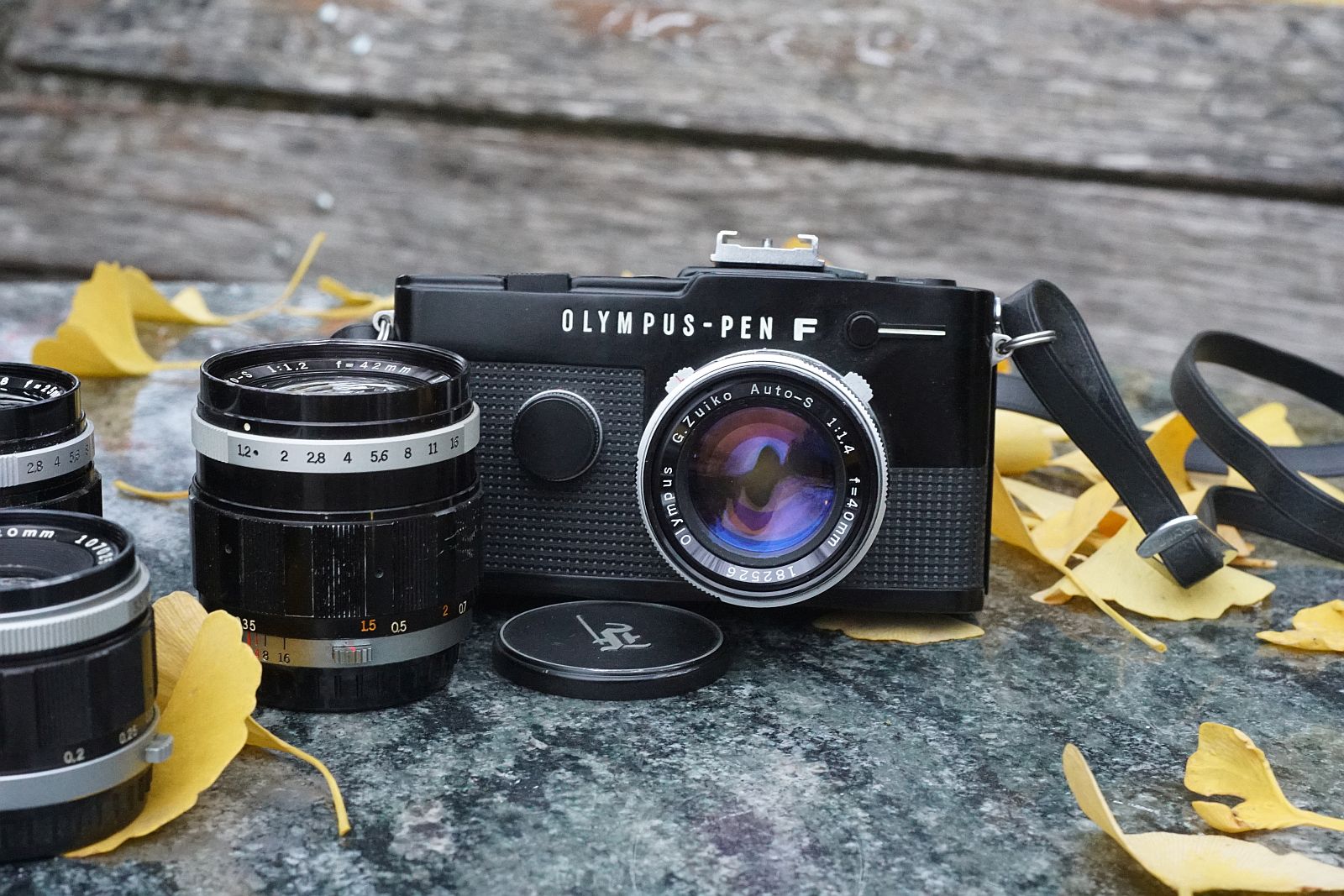
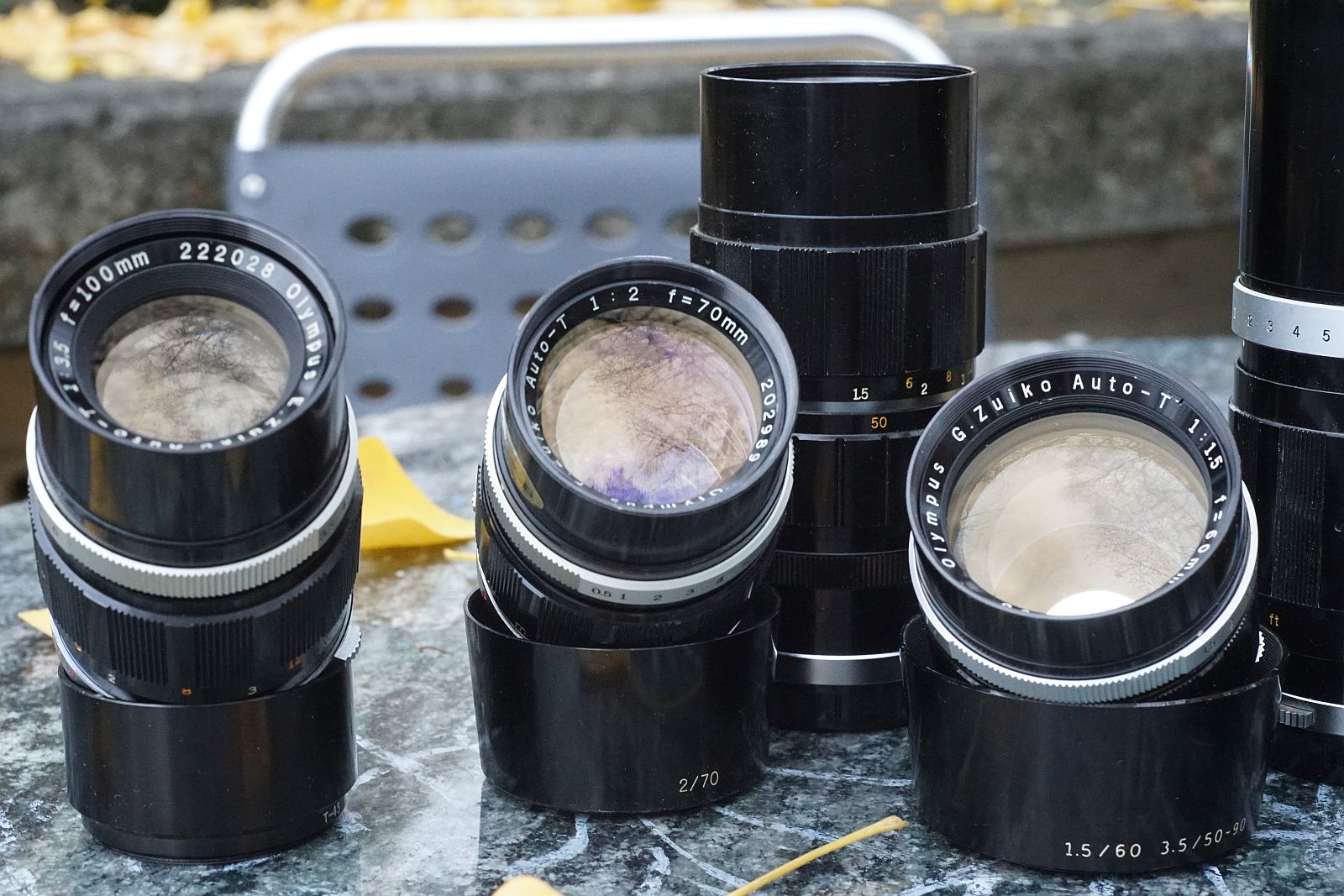
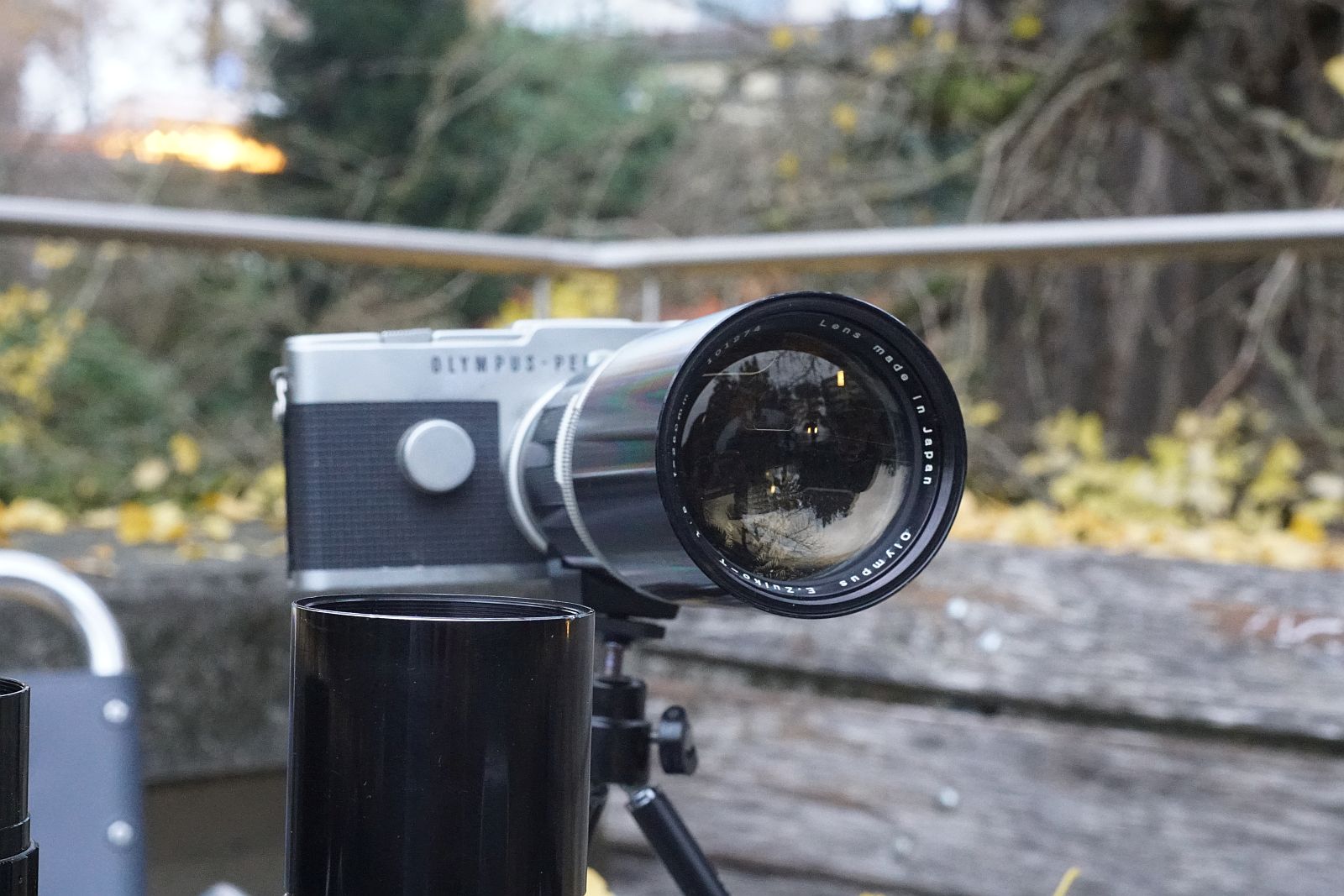 |
|
| Back to top |
|
 |
55


Joined: 13 May 2013
Posts: 718
Location: U.S.
Expire: 2022-06-15
|
 Posted: Tue Nov 29, 2022 5:21 pm Post subject: Posted: Tue Nov 29, 2022 5:21 pm Post subject: |
 |
|
55 wrote:
| starbucklover69 wrote: |
This is my little Olympus Pen F Collection.
. . . |
Welcome, starbucklover69. That's a nice presentation of a beautiful collection!
I know little about Olympus Pen F, but I'm guessing it took you a long time to assemble your horde?
Which item was the most difficult to obtain? |
|
| Back to top |
|
 |
starbucklover69
Joined: 27 Nov 2022
Posts: 46
Location: Swiss
|
 Posted: Tue Nov 29, 2022 5:56 pm Post subject: Posted: Tue Nov 29, 2022 5:56 pm Post subject: |
 |
|
starbucklover69 wrote:
| 55 wrote: |
| starbucklover69 wrote: |
This is my little Olympus Pen F Collection.
. . . |
Welcome, starbucklover69. That's a nice presentation of a beautiful collection!
I know little about Olympus Pen F, but I'm guessing it took you a long time to assemble your horde?
Which item was the most difficult to obtain? |
The 40 f1.4 and the 60 f1.5. I found the 42mm 10 years ago for 20 Swiss francs. I have been searching and collecting the Pen f series ever since. I exchanged the 60mm for 6 Minolta x700 with lenses. I ordered the PenF-Mft adapter. Comes in mid-December. I already have the adapter for the Sony. |
|
| Back to top |
|
 |
starbucklover69
Joined: 27 Nov 2022
Posts: 46
Location: Swiss
|
 Posted: Tue Nov 29, 2022 5:58 pm Post subject: Posted: Tue Nov 29, 2022 5:58 pm Post subject: |
 |
|
starbucklover69 wrote:
| 55 wrote: |
| starbucklover69 wrote: |
This is my little Olympus Pen F Collection.
. . . |
Welcome, starbucklover69. That's a nice presentation of a beautiful collection!
I know little about Olympus Pen F, but I'm guessing it took you a long time to assemble your horde?
Which item was the most difficult to obtain? |
Here is a german Site for the Pen F. https://olypedia.de/index.php?title=Kategorie:PEN_F_System |
|
| Back to top |
|
 |
55


Joined: 13 May 2013
Posts: 718
Location: U.S.
Expire: 2022-06-15
|
 Posted: Wed Nov 30, 2022 5:01 pm Post subject: Posted: Wed Nov 30, 2022 5:01 pm Post subject: |
 |
|
55 wrote:
| starbucklover69 wrote: |
. . .
The 40 f1.4 and the 60 f1.5. I found the 42mm 10 years ago for 20 Swiss francs. I have been searching and collecting the Pen f series ever since. . . |
 I know how rewarding it is to find an item after a long search. I know how rewarding it is to find an item after a long search.
Thank you. I never knew there were so many lenses for Pen F. |
|
| Back to top |
|
 |
Alun Thomas

Joined: 20 Aug 2018
Posts: 664
Location: New Zealand
|
 Posted: Fri Dec 02, 2022 12:00 am Post subject: Posted: Fri Dec 02, 2022 12:00 am Post subject: |
 |
|
Alun Thomas wrote:

These two cameras are both rebadged Petri cameras, marketed by Ihagee West, after they won a court case with the East German company of the same name. Their first release was the Exakta Real, using a new bayonet mount. Following that was the Twin TL, a Cosina Hi-Lite rebadge, still using the new mount. Then it was released in M42, and then following that, these two Petri cameras, based on the Petri 1/1000s M42 chassis, were released. The 55/1.8 lens on the left is a Petri made lens with a decent reputation. The one on the right looks to be made by Sankor, possibly based on previous 55/1.4 designs from other manufacturers.
The cameras are almost identical apart from the omission of the 1/1000s speed and the timer from the left hand camera. Actually there is a further difference, in the metering system. On the TL-500, the metering works anytime the stop down button is used, exactly the same as any other M42 stop down camera from that period. On the TL-1000, the meter turns on when the camera shutter is cocked, and off when the shutter is released. This setup was first featured on the Petriflex 7 camera, and is retained here. You still have to stop down manually with the same lever as on the TL-500.
This caused me some confusion when I received the TL-1000, I though the meter was defective. When I took the top cover off to try and fix the perceived 'fault', I noticed the camera is quite nicely made, despite the lowly reputation (not) enjoyed by Petri cameras. |
|
| Back to top |
|
 |
stevemark

Joined: 29 Apr 2011
Posts: 4088
Location: Switzerland
|
 Posted: Sat Feb 11, 2023 9:45 pm Post subject: Minolta Dynax 7D Posted: Sat Feb 11, 2023 9:45 pm Post subject: Minolta Dynax 7D |
 |
|
stevemark wrote:
Today I got another Minolta Dynax 7D, together with the iconic Minolta AF 2.8/28-70mm G lens (not shown here). The "D7D", as she was known in Europe, was Minoltas first "real" DSLR, and she sold in truckloads, at least here in Switzerland. At around CHF 3000.-- the camera was quite expensive, but that was kind of "normal" back then. Everyone was jumping on the DSLR bandwagon, including Minolta, finally. They were quite late since their the CEO had determined, in the mid-1990s, that "digital" would remain a niche market and APS would be the "next big thing". Of course the market wasn't inclined to obey him, but - to save face - he couldn't immediately change his assessment when "digital" became ubiquituous. The Minolta engineers were pretty upfront, but they were banned to put their high-tech into a decent SLR. First the very expensive digital stuff was put into one of the cheapest plastic Minolta bodies (instead of the beautiful Dynax/Alpha 9); later on they - at least - managed to put it into a excellent "bridge" camera with a 28-200mm (eqiv) fast zoom. Its last incarnation - the Minolta Dimage A2 and A200 - had a full metal body, 8 MP (quite a feat in early 2004), a 2.8-3.5/28-200mm (equiv) APO zoom lens and, last but not least, an integrated antishake mechanism.
Back to the Minolta Dynax 7D. Announced pretty early (remember: Minolta was late), it hit the market at the end of 2004. I got one of the first cameras then, and it had a HUGE flaw: The sensor was slightly tilted - which resulted in images either sharp at the top OR at the bottom, but not both (unless you stopped down to f16 or f22). Bummer ... turns out it wasn't Minoltas error, but Sonys: They had glued the sensor with uneven amounts of glue onto the base, thus resulting in a "tilted" sensor ... Apart from that issue (which was solved within a few weeks) the camera was an immediate success. Mine paid off completely with the very first assigment i had, and soon some nice lenses were following.

Here's an image of two samples of the Dynax (Maxxum) 7D - one with and one without the power grip. For a prosumer camera, the D7D was incredibly well made: Full metal body, and lots and lots and lots of dedicated buttons, sliders and switches. More on that later - first two more images of the camera itself:

Here it is shown with the Minolta 3.5-4.5/24-105mm standard zoom. It was a "analog" lens, but quite well suited for the 6MP sensor of the Dynax 7D.

_________________
www.artaphot.ch |
|
| Back to top |
|
 |
Doc Sharptail


Joined: 23 Nov 2020
Posts: 1216
Location: Winnipeg Canada
|
 Posted: Sun Feb 12, 2023 5:15 pm Post subject: Posted: Sun Feb 12, 2023 5:15 pm Post subject: |
 |
|
Doc Sharptail wrote:
The Konica/Minolta badging is seldom seen here.
Odd that there were problems mounting the Sony sensor- likely a manufacturing floor problem.
Still a bit strange for someone with Sony's long term video sensor experience to not specify mounting procedures.
I wonder how corporate relations were before Sony took over.
-D.S.
_________________
D-810, F2, FTN.
35mm f2 O.C. nikkor
50 f2 H nikkor, 50 f 1.4 AI-s, 135 f3.5 Q,
50 f2 K nikkor 2x, 28-85mm f3.5-4.5 A/I-s, 35-105 3.5-4.5 A/I-s, 200mm f4 Micro A/I, partial list.
"Ain't no half-way" -S.R.V.
"Oh Yeah... Alright" -Paul Simon |
|
| Back to top |
|
 |
55


Joined: 13 May 2013
Posts: 718
Location: U.S.
Expire: 2022-06-15
|
 Posted: Sun Feb 12, 2023 5:21 pm Post subject: Posted: Sun Feb 12, 2023 5:21 pm Post subject: |
 |
|
55 wrote:
| Alun Thomas wrote: |
These two cameras are both rebadged Petri . . . |
| stevemark wrote: |
| Today I got another Minolta Dynax 7D . . . |
Interesting historical information! |
|
| Back to top |
|
 |
stevemark

Joined: 29 Apr 2011
Posts: 4088
Location: Switzerland
|
 Posted: Mon Feb 13, 2023 10:45 pm Post subject: Posted: Mon Feb 13, 2023 10:45 pm Post subject: |
 |
|
stevemark wrote:
| 55 wrote: |
| Alun Thomas wrote: |
These two cameras are both rebadged Petri . . . |
| stevemark wrote: |
| Today I got another Minolta Dynax 7D . . . |
Interesting historical information! |
Mainly based on discussions with the editor of "Sony Fotospiegel" (formerly "Minolta Fotospiegel") around 2008-2012, when I regularly did contribute to that magazine  . The said editor had been in close contact with Minolta Japan since the mid-1970s. So he knew quite a few "inside" stories . The said editor had been in close contact with Minolta Japan since the mid-1970s. So he knew quite a few "inside" stories 
Back to the D7D and its user interface - probably the best of any DSLR Im aware of. While it may look complicated at the beginning, it allows for direct control of all the essential functions without divinginto the menu (or sub-menu). Really impressive, and probably incredibly expensive to manufacture. Well, the D7D was "Malaysia", not "Japan", so ....
I always thought that all functions influencing the RAW data should be accessible directly (is without going into the menu). THe D7D is the only camera I'm aware of allowing this.
Here's the traditional "M-S-A-P" knob, allowing to select the respective mode. In addition there's the "green P" mode (everything including white balance is automatic), and three programmable modes "1-2-3". Nothing unusual here.
But then there's the selector for the white balance. Quite unusual and very useful - direct access to automatic WB, programmed WB (such as "sun", "clouds", shadow" ...), measured WB (three memory places), and Kelvin based WB.

_________________
www.artaphot.ch |
|
| Back to top |
|
 |
stevemark

Joined: 29 Apr 2011
Posts: 4088
Location: Switzerland
|
 Posted: Mon Feb 13, 2023 10:50 pm Post subject: Posted: Mon Feb 13, 2023 10:50 pm Post subject: |
 |
|
stevemark wrote:
Now the on/off switch and the +/- dial.
Again the first is as its is, but the +/- dial is pretty ingeniuous: The dial consists of two levels - upper dial for over-/underexposure of the ambient light, and the lower dial for over-/underexposure of the flash (built-in or external). In addition the dial for ambient light has two settings: either +/- 2 EV in 1/3EV steps, or+/- 3EV in 1/2 EV steps. To avoid unintentional shifting of the values, theres a small central "lock" button. Very well done. Compare this to the Nikon D2/D3/D4 ... or the Canon 1D series and you'll always prefer the Minolta solution ... !!

_________________
www.artaphot.ch |
|
| Back to top |
|
 |
stevemark

Joined: 29 Apr 2011
Posts: 4088
Location: Switzerland
|
 Posted: Mon Feb 13, 2023 10:56 pm Post subject: Posted: Mon Feb 13, 2023 10:56 pm Post subject: |
 |
|
stevemark wrote:
The Minolta Dynax (Maxxum) 7D was the first ever SLR with built-in image stabilisation. Combined with the relatively high sensitivity of the sensor I suddenly was able to take tack sharp images in "impossible" situations. The IS was working reliably right from the beginning; no issues with it at all. Incredibly useful for lenses such as the 2.8/20, the 2/28, the 1.4/50 and the 1.4/85mm, for sure.
And of course there was a dedicated slide switch for turning it on and off!
BTW the "MSET" button gives you direct access to programming the three programmable memory settings (once programmed, they are accessible via the main "1-2-3" knob on top of the camera)

_________________
www.artaphot.ch |
|
| Back to top |
|
 |
stevemark

Joined: 29 Apr 2011
Posts: 4088
Location: Switzerland
|
 Posted: Mon Feb 13, 2023 11:15 pm Post subject: Posted: Mon Feb 13, 2023 11:15 pm Post subject: |
 |
|
stevemark wrote:
Now the AF system! The AF itself is pretty slow copared to todays DSLRs, butit certainly was way faster than the first mirrorless AF systems (inclusding those from Sony). I am still puzzled that an A7II with dedicated Sony 1.8/85mm doesn't focus faster than a Minolta 9000 from 1986!! Anyway. The D7D AF was (is) noisy, not really precise and not really fast. AND for best performance you had to send your camera PLUS your lenses to Minolta Switzelrland, and have the stuff calibrated individually. Backfocus and frontfocus issues were pretty common back then, and the Minolta D7D had less issues with it than eg the contemprorary Canon prosumer DSLRs.
The AF "command center" had three levels:
1) a central button for activating the central f2.8 AF sensor
2) a toggle switch for accessing the outer AF sensors
3) and an outer rotary switch for selecting the AF mode (wide field, locked, or single sensors)
No unseen in other contemporary DSLRs, but quite good for a prosumer DSLR.

_________________
www.artaphot.ch |
|
| Back to top |
|
 |
stevemark

Joined: 29 Apr 2011
Posts: 4088
Location: Switzerland
|
 Posted: Mon Feb 13, 2023 11:23 pm Post subject: Posted: Mon Feb 13, 2023 11:23 pm Post subject: |
 |
|
stevemark wrote:
AF system, #2:
There's a dedicated rotary switch for selecting "manual focus", "single AF". "automatic AF" (switching automatically between "single" and "continuous") and "continuous AF".
In addition there's another AF/MF toggle switch, but more on that later!
Quite standard as well with many SLRs and DSLRs, but nicely made.
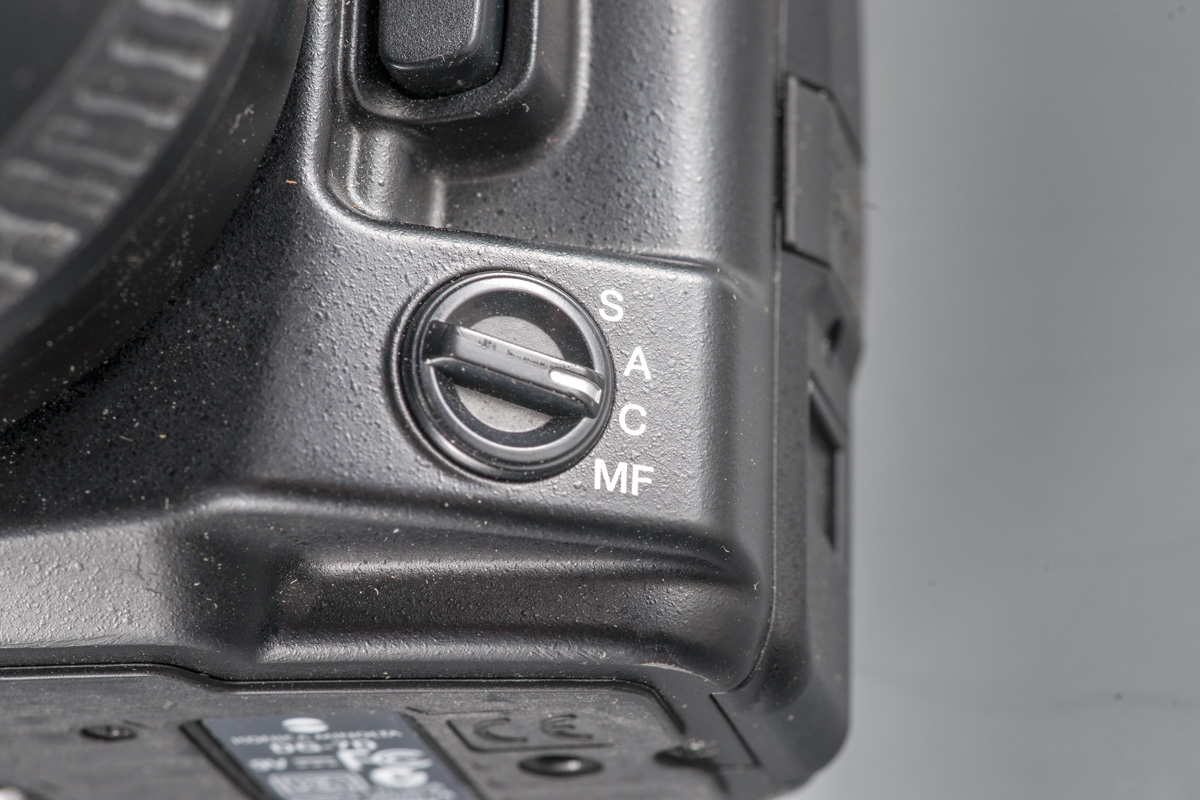
_________________
www.artaphot.ch
Last edited by stevemark on Tue Feb 14, 2023 12:16 am; edited 2 times in total |
|
| Back to top |
|
 |
stevemark

Joined: 29 Apr 2011
Posts: 4088
Location: Switzerland
|
 Posted: Tue Feb 14, 2023 12:04 am Post subject: Posted: Tue Feb 14, 2023 12:04 am Post subject: |
 |
|
stevemark wrote:
Finally the remaining control units!
As you can see, below the "M-S-A-P" selector theres a second rotary switch. That lower level give direct access to the "frame per second" menu. Since the D7D is fairly slow (3 fps), it has only the positions "single" and "continuous" (=3 fps).
However, with the same rotary switch you can directly engage the 10s and the 2s self-timer, the latter conveniently combined with mirrol lock up MLU).
And finally the switch has another two positions with direct access to the bracketing functions (again "single" or "continuous"). The number of frames for bracketing (three or five) and the respective EV difference betwee frames (1/3EV or 1/2EV) must first be programmed via the menu; once it is determined, the bracketing function can be accessed without diving into the menu. Quite remarkable indeed.
Below we see the "AEL" button ahich is very useful. Once it is pressed, the AE is locked. If a dedicated flash (or the built-in flash) is used, pressing the AEL button results in "slow sync" flash: half of the light is ambient ("available light"), ad half comes from the flashgun. This function came first with the analog Minolta AF cameras, and it was (is) extremely useful for reportage and wedding photography.
Around the AEL button there's another rotary switch, again with three positions for selecting the different light meteriung modes:
* spot
* multi metering
* average
Hidden under the eye-cup (barely visible) is the rotary knob for adjusting the diopters (+3 to -3 diopters). Another feat that was quite uncommon in prosumer cameras back then.
Finally - last but not least - we have the front- and the back wheel for adjusting aperture and shutter speed. Unlike the much more expensive professional Nikon and Canon DLSRs (D1 / D2 and 1D-series), the Minolta wheels had its wheels angled in an ergonomically perfect position (Nikon D1/D2 had its wheels just "laying flat" [=horizontally], and Canon EOS 1D / 1DMkII was perpendicular / 90°). Minolta (and Sony!) wheels are more expensive to produce, but much nicer to use ...!
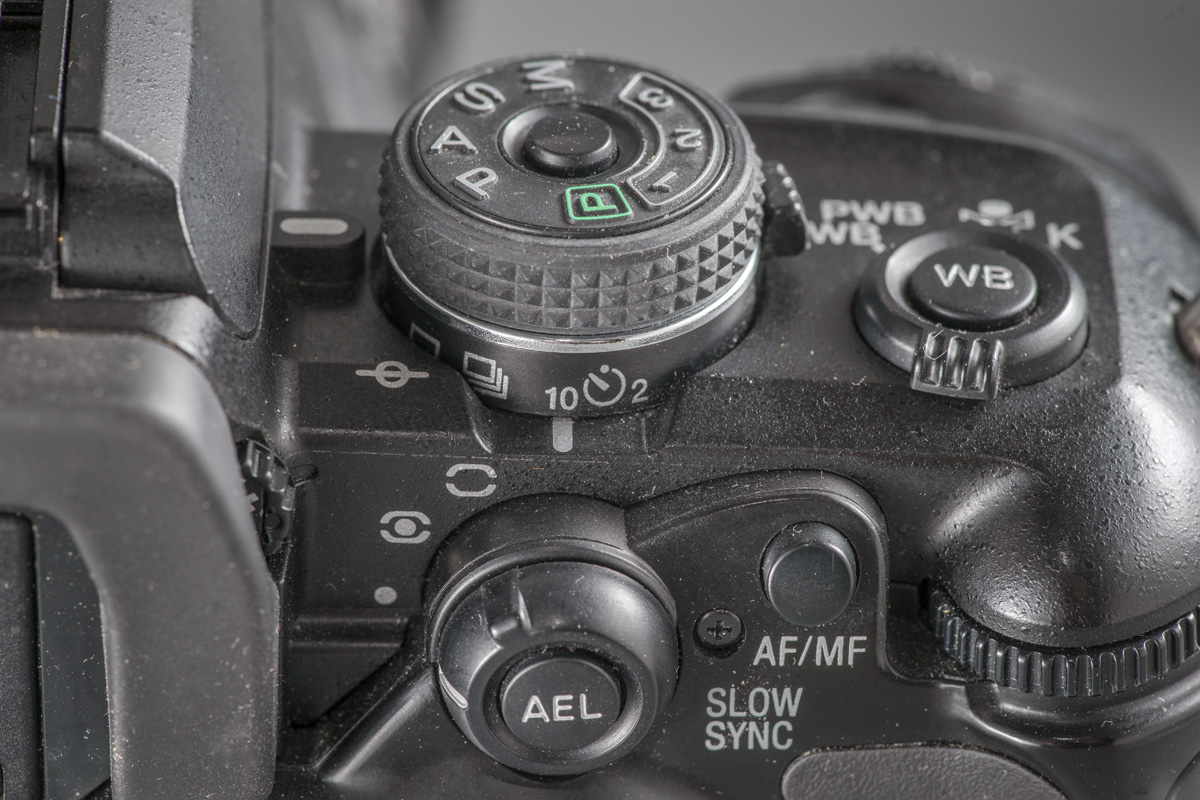
OK - this was it ...! I have been using the D7D from Dec 2004 to Oct 2007, and it was a real improvement over my Nikon D1. Twice as much pixels, much better colors, and much easier to work with. Then, at the end of October 2007, I had the rare opportunity to work in Bhutan, and litterally on the evening before my departure I got one of the very first Sony A700 cameras available here in Switzerland. But that's another story 
S
EDIT: I forgot the "AF/MF" button! That one was added first to the anaolg Dynax 7 a few years ago. Minolta users had complained that Canon (and to some extent also Nikon) users had the ability for "direct manual focusing" when using lenses with an USM AF motor. In 2004 Minolta had only two lenses with USM (SSM) motors, the 2.8/70-200 APO G SSM and the 2.8/300 APO G SSM. Nobody was using them, and for all the "screwdriver" lens users Minolta added the "AF/MF" switch: Press the button => lens is MF; let loose => AF again ...
Well, it wasn't as useful as they had hoped, and it required an additional (expensive) clutch mechanism in the AF drivetrain ... !
_________________
www.artaphot.ch |
|
| Back to top |
|
 |
stevemark

Joined: 29 Apr 2011
Posts: 4088
Location: Switzerland
|
 Posted: Tue Feb 14, 2023 11:13 pm Post subject: Posted: Tue Feb 14, 2023 11:13 pm Post subject: |
 |
|
stevemark wrote:
Here's another one, about 25 years old now - the Minolta Dynax (Maxxum) 9. It was (and is) one of my favourite analog SLRs, along with such classics as the Canon New F-1, the Nikon F3 and F5, and the Pentax LX. Here it's shown with my recently acquired Minolta AF 2.8/28-70mm G zoom which was Minoltas best (and most expensive) standard zoom.
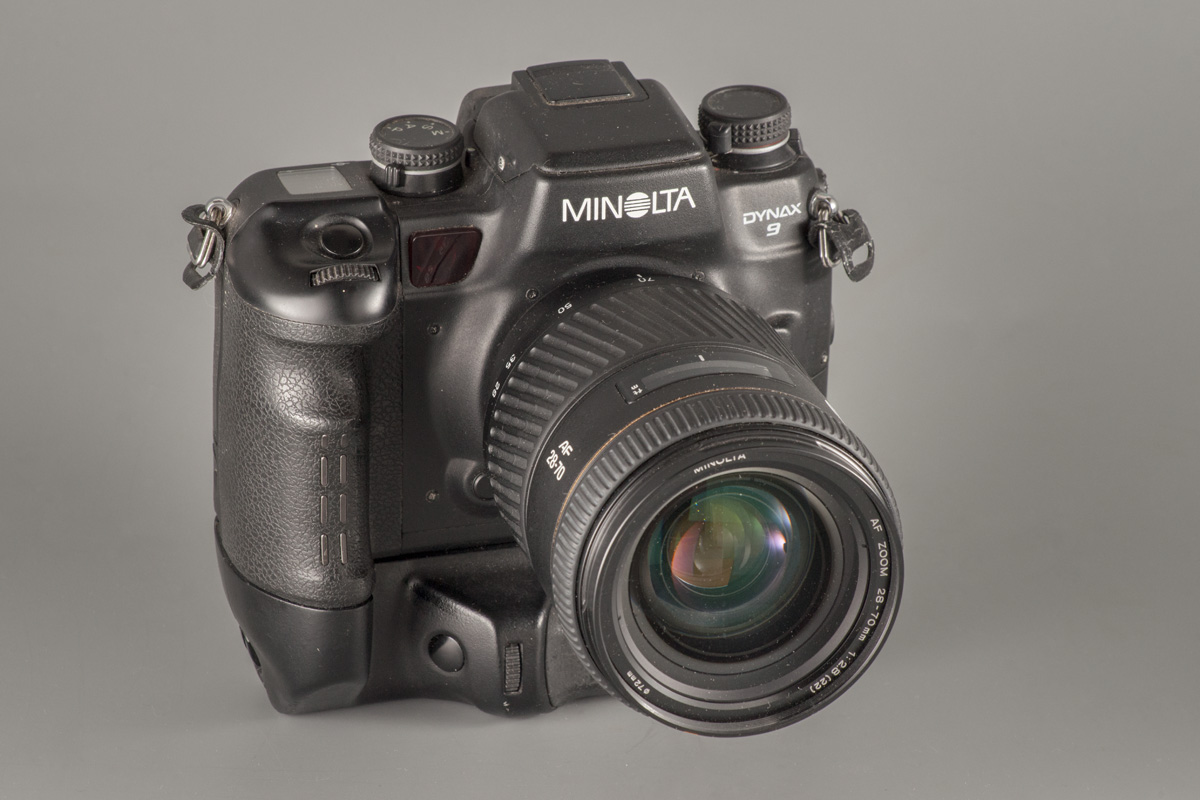
Apart from the fact that the Dynax 9 did have a built-in flash, it was unique since its body was made from stainless steel. The camera therefore was extremely rugged; I remember it once fell (during a rock concert; dense crowd and quite a crush) on the concrete floor below - and continued working. Maybe a year or so later I tripped over someting while rushing for a train; the D9 literally was kicked off my hands, flew 3-4 meters through the air and fell ... well: on concrete, again. This time - while the camera was still working - the upper part of the body was slightly twisted, and there was small gap between upper part and mid-section. Maybe half a millimeter, but enough that the body wouldn't be protected against moisture any more. It had to be repaired at Minolta Switzerland.
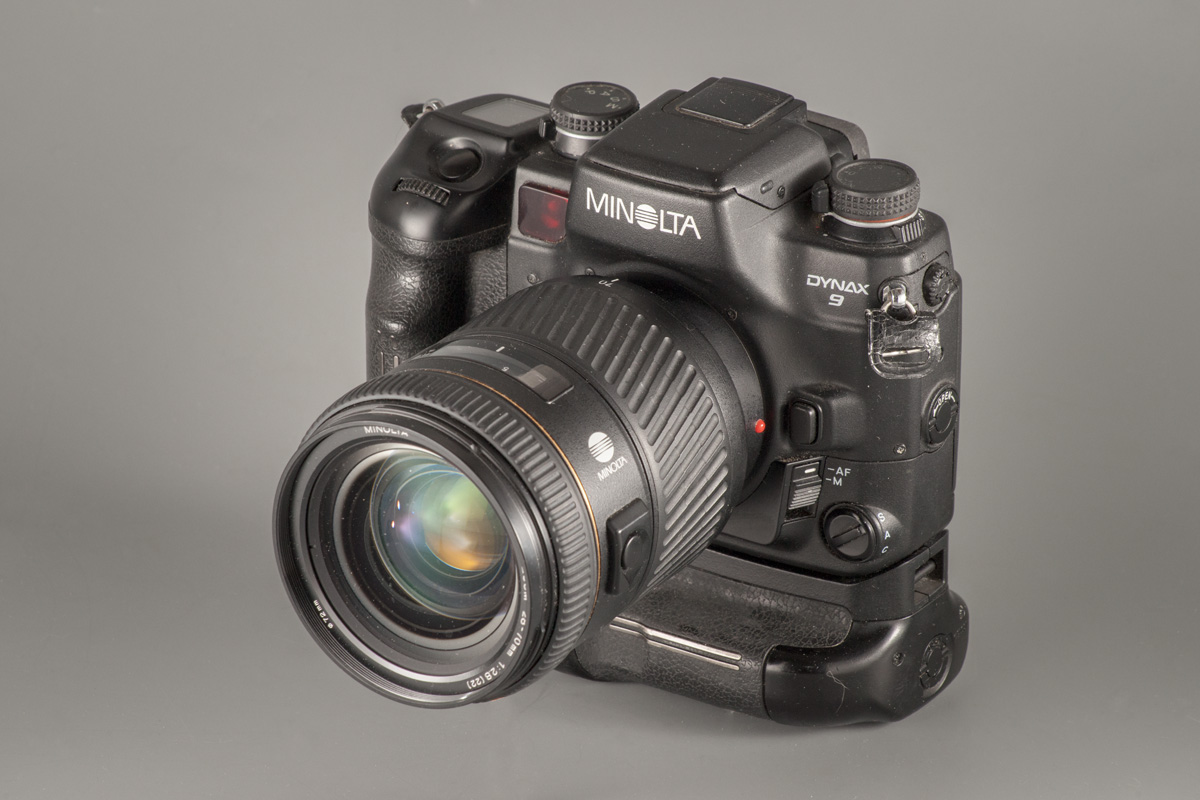
If you look at both the camera grip and the vertical grip, you can see how much attention to detail the camera was given. Those grips are much better than anything that CaNikon have produced in the SLR/DSLR field. The camera was extremely responsive. Those metal strips on the grip are activating the Dynax 9 as soon as you pick it up, and when you approach the viewfinder, another sensor is activating the autofocus. While I never really liked the earlier Dynax (Maxxum) 9xi, the Dynax 9 was an immediate joy to work with. It is no secret that the later "digital D9" - which was later released as the Sony A900 - was a direct descendant of the Minolta Dynax 9.
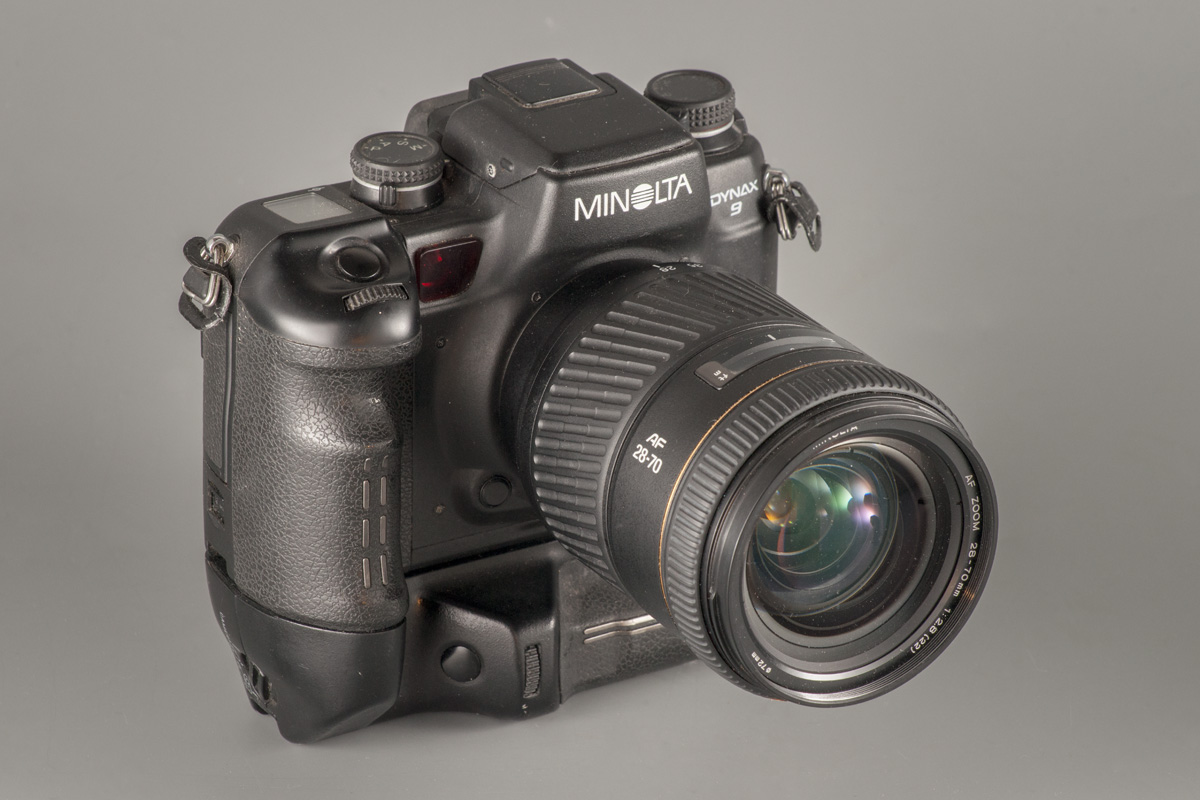
S
_________________
www.artaphot.ch |
|
| Back to top |
|
 |
Doc Sharptail


Joined: 23 Nov 2020
Posts: 1216
Location: Winnipeg Canada
|
 Posted: Wed Feb 15, 2023 6:40 am Post subject: Posted: Wed Feb 15, 2023 6:40 am Post subject: |
 |
|
Doc Sharptail wrote:
From a user standpoint- physical ergonomics only, the grips on the MD-11 & MD-12 (FM & FE) were about the best "feel" in my hands.
While not as technologically advanced as the Minolta offerings above, they made perfect physical sense to me.
The MD-4 on the F3 was a big, chunky, blocky, and heavy poorly designed contraption that I had little interest in, but there are legions of F3 users that loved it, and swore by it as well.
I've gotten used to the grip on the D-810.
Personally, I find the design a little cramped, and still need care to not un-intentionally activate the function- a/f-a/e lock buttons. A 2 or 3 mm wider spacing between the grip and the lens mount would work wonders. I'd need to go to the D-5/6 to get it though.
-D.S.
_________________
D-810, F2, FTN.
35mm f2 O.C. nikkor
50 f2 H nikkor, 50 f 1.4 AI-s, 135 f3.5 Q,
50 f2 K nikkor 2x, 28-85mm f3.5-4.5 A/I-s, 35-105 3.5-4.5 A/I-s, 200mm f4 Micro A/I, partial list.
"Ain't no half-way" -S.R.V.
"Oh Yeah... Alright" -Paul Simon |
|
| Back to top |
|
 |
ZuikosHexanonsandVivitars


Joined: 03 Nov 2021
Posts: 254
Location: Austria
|
 Posted: Wed Feb 15, 2023 1:20 pm Post subject: Posted: Wed Feb 15, 2023 1:20 pm Post subject: |
 |
|
ZuikosHexanonsandVivitars wrote:
| stevemark wrote: |
| ZuikosHexanonsandVivitars wrote: |
My OM-2N and the two silver noses I own.
|
A very nice camera for sure! Sadly the Zuiko lenses are quite scarce here in Switzerland (apart from ubiquituous 1.8/50, 3.5/28 and 3.5/135 Zuikos), and in addition tho the 1.8/50 and the 3.5/28 I only have a 3.5/21, the 1.4/50, the 2.8/135 and the 4.5/300 (plus a few zooms).
| ZuikosHexanonsandVivitars wrote: |
This OM-2SP ate batteries like candies, luckily of the LR-44 type. So supply is still good, I might try a color negative film with it once the Ilford in the OM-3 is spent. I bought this camera in the 90s, when everybody was keen on autofocus, for very little money.
|
OM-3 and 2.8/180 ... what a beautiful combination! I've never seen a 2.8/180, and i would love to see how it performs since its construction is a bit different from most other fast 180mm / 200mm lenses.
S |
Stefan, I didn´t notice your reply (until today), sorry for that!
Since I started again looking for Zuikos on ebay & co. some two years ago, they became more and more scarce everywhere. So I´m quite happy with what I have from analog times. Still, my Olympus lenses are nothing a collector would get excited about. But they are a very practical set of lenses mostly f2.8 and covering almost the whole range from 24 to 300mm. The usual surplus of fifties, whereas the 1.4 with its 1.1mio serial number and the 1.2 stick out a bit. Sadly, I never had a good opportunity to get a 85mm Zuiko. They always were expensive.
My three teles of 100/2.8, 135/2.8 and 180/2.8 are all MC, and I am damn happy about that. Only the 300mm f4.5 is a black single coated version and therefore fringing heavily. Apart from this one, all Zuikos are solid to outstanding performers and produce a "modern" look without or very little hints of vintage nostalgy.
I haven´t used the 180mm often recently, but it´s a good idea to change that if the weather is not abysmal coming weekend. From the few occasions in recent months I find it has a pleasant bokeh, is already sharp wide open, being best (as usual) from f4 to f8, has good contrasts and color rendition. If a comparison in such way is legit at all, I´d say it keeps performance-wise slightly behind the shorter 100/2.8 and 135/2.8, which are just excellent. A big treat comes from the handy form factor of the 180/2.8. Olympus has filed a patent for this lens in the US, calling it a "variant Ernostar type long focus lens system having a very short overall length".
https://image-ppubs.uspto.gov/dirsearch-public/print/downloadPdf/4114992
Afore mentioned 135mm and 100mm lenses have a similar 5-lens configuration. It might be that Olympus has reached a useful limit of this config around 180mm. Or they have outmaxed it in their desire to create a light and short lens. Both could explain the slightly less good performance of the 180/2.8 in comparison to the other two (which is still my very personal perception and humble opinion). Being not educated in this area, I can only speculate, but looking at the rare and expensive Zuiko 180mm f2.0, which uses 10 instead of 5 lenses, is probably the best way to see what Olympus could do, if optical excellence is prime and money (and bag capacity  ) a secondary issue. ) a secondary issue.
_________________
Cheers, Gerhard |
|
| Back to top |
|
 |
stevemark

Joined: 29 Apr 2011
Posts: 4088
Location: Switzerland
|
 Posted: Tue Feb 21, 2023 5:43 pm Post subject: Posted: Tue Feb 21, 2023 5:43 pm Post subject: |
 |
|
stevemark wrote:
| ZuikosHexanonsandVivitars wrote: |
Sadly, I never had a good opportunity to get a 85mm Zuiko. They always were expensive. |
Did you know there was a very sophisticated Olmpus Zuiko 1.4/85mm, too? Prototype only, though ... 
| ZuikosHexanonsandVivitars wrote: |
| My three teles of 100/2.8, 135/2.8 and 180/2.8 are all MC, and I am damn happy about that. |
I only know the 2.8/135mm which I got a year ago for about CHF 40.-- from a photo dealer in Zurich. To be honest - I haven't really been using it, just a few test shots. Maybe I should try it again. Both the 2.8/100mm (which occasionally appears here in Switzerland) and the 2.8/180 look pretty interesting to me, but since they usually are pretty expensive I didn't buy them. And collecting the more interesting f2 Oly lenses immediately gets even more expensive. occasionally they appear here, too, but the sellers often want >1000.-- for these lenses (2/21, 2/24, 2/50 Macro, 2/90 Macro, 2/100).
| ZuikosHexanonsandVivitars wrote: |
| Only the 300mm f4.5 is a black single coated version and therefore fringing heavily. Apart from this one, all Zuikos are solid to outstanding performers and produce a "modern" look without or very little hints of vintage nostalgy. |
Dunno how you distinguish between "MC" and "non-MC" Zuikos - but mine has some single coated lenses (brownish coating) and some multi coated lenses (greenish coating). My Olympus Zuiko 4.5/300 fringes quite a bit too, but that's more a problem of the focal length than of coating. Most vintage 300mm do this, apart from the "APO" / ULD / ED / AD glass. Even the Nikkor AiS IF-ED 4.5/300mm has quite a lot of fringing!
| ZuikosHexanonsandVivitars wrote: |
I haven´t used the 180mm often recently, but it´s a good idea to change that if the weather is not abysmal coming weekend. From the few occasions in recent months I find it has a pleasant bokeh, is already sharp wide open, being best (as usual) from f4 to f8, has good contrasts and color rendition. If a comparison in such way is legit at all, I´d say it keeps performance-wise slightly behind the shorter 100/2.8 and 135/2.8, which are just excellent. A big treat comes from the handy form factor of the 180/2.8. Olympus has filed a patent for this lens in the US, calling it a "variant Ernostar type long focus lens system having a very short overall length".
https://image-ppubs.uspto.gov/dirsearch-public/print/downloadPdf/4114992 |
Thanks for that information, especially for the linked US patent info. The optical construction of the Oly 2.8/180 is even more unusual than I had anticipated. Not only is the lens section stronlgy reminding of certain 135 mm lenses, but also the glasses used have a surprisingly high refractive index (around 1.64 - 1.7 for the first three large positive lenses), but also their Abbé number is surprisingly low (= stronger CAs). An Abbé number of 50 to 55 is really unusual for a fast f2.8 tele with about 200mm focal length!! Canon was using an LD glass with an Abbé number of 70 even for their slow nFD 4/200mm ...
| ZuikosHexanonsandVivitars wrote: |
| Afore mentioned 135mm and 100mm lenses have a similar 5-lens configuration. It might be that Olympus has reached a useful limit of this config around 180mm. Or they have outmaxed it in their desire to create a light and short lens. Both could explain the slightly less good performance of the 180/2.8 in comparison to the other two (which is still my very personal perception and humble opinion). |
That's probably quite accurate. Going for "small lenses", Olympus went fro the Ernostar design even with its 200mm class lens, while most other contemporary 2.8/200mm lenses were tele constructions with a triplet in front and a negative doublet at the rear (to shorten the overall length of the system, and to correct for field curvature). Those triplets often had their two positive lenses made
from ED glass with an Abbé number v=70. Notable exceptions were the Konica Hexanon AR 4/200mm (v=64, which means more CAs), and the Nikkor ED 2.8/180 with ULD glass (v about 80, which means better color correction).
| ZuikosHexanonsandVivitars wrote: |
Being not educated in this area, I can only speculate, but looking at the rare and expensive Zuiko 180mm f2.0, which uses 10 instead of 5 lenses, is probably the best way to see what Olympus could do, if optical excellence is prime and money (and bag capacity  ) a secondary issue. ) a secondary issue. |
That one is a later construction of course. The Olympus 2/180mm, 2/250mm and 2.8/350mm lenses are at least ten years younger than the Oly 2.8/180mm. Now ED/ULD (originally by Schott) and AD (Minolta) glass and even Fluorite (Canon) was available in reasonable amounts, thus allowing the calculation and production of much more sophisticated lens designs.
S
_________________
www.artaphot.ch |
|
| Back to top |
|
 |
stevemark

Joined: 29 Apr 2011
Posts: 4088
Location: Switzerland
|
 Posted: Tue Feb 21, 2023 7:46 pm Post subject: Nikon F3 with different lenses Posted: Tue Feb 21, 2023 7:46 pm Post subject: Nikon F3 with different lenses |
 |
|
stevemark wrote:
Usually cameras shown here have just their normal lens attached. An 1.4/50, an 1.7/55 or whatever. Sometimes we see a fast lens, sometimes an "ordinary" 4/35mm wideangle. Or a 4/135mm tele lens.
That's not only true here, but also in the entire web. One rarely finds nice images of nice cameras with a nice fast lens attached.
The first 50 hits when searching for images using "Nikon F3 Nikkor 1.8 105mm" for instance were displaying two images of the 1.8/105mm with an FM3A, one image of the 1.8/105mm with an FA, but none with the F3. All other images show either only the 1.8/105mm lens, or (mostly) just other lenses and/or cameras. Pretty poor.
Let's change that 
Here are a few images of a Nikon F3 with different fast lenses. Nothing special or rare at all, but nevertheless ... just for fun  ! !
First the F3 with a nice Nikkor Ai 1.2/55mm normal lens:

F3 with an Ai converted Nikkor K 1.8/85mm:
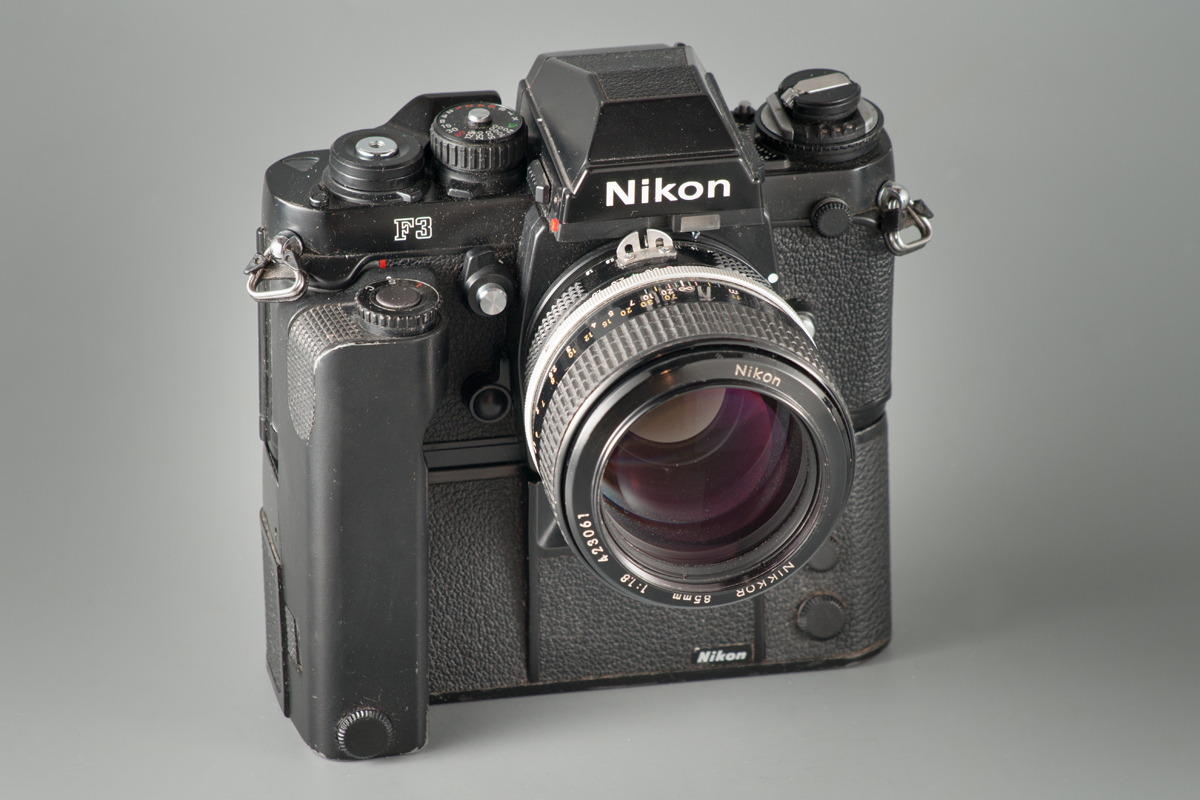
Here with the large and fast Nikkor AiS 1.8/105mm:
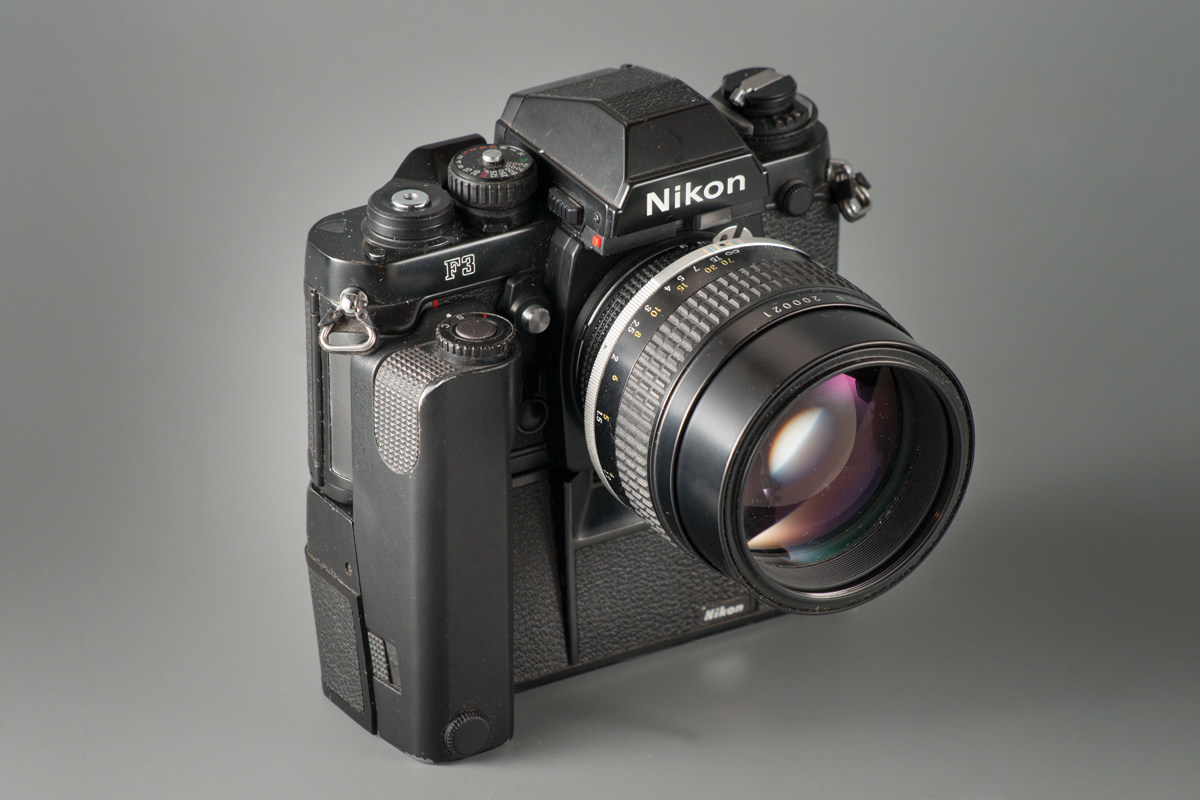
And finally with a nice looking Nikkor AiS 2.8/180mm ED:
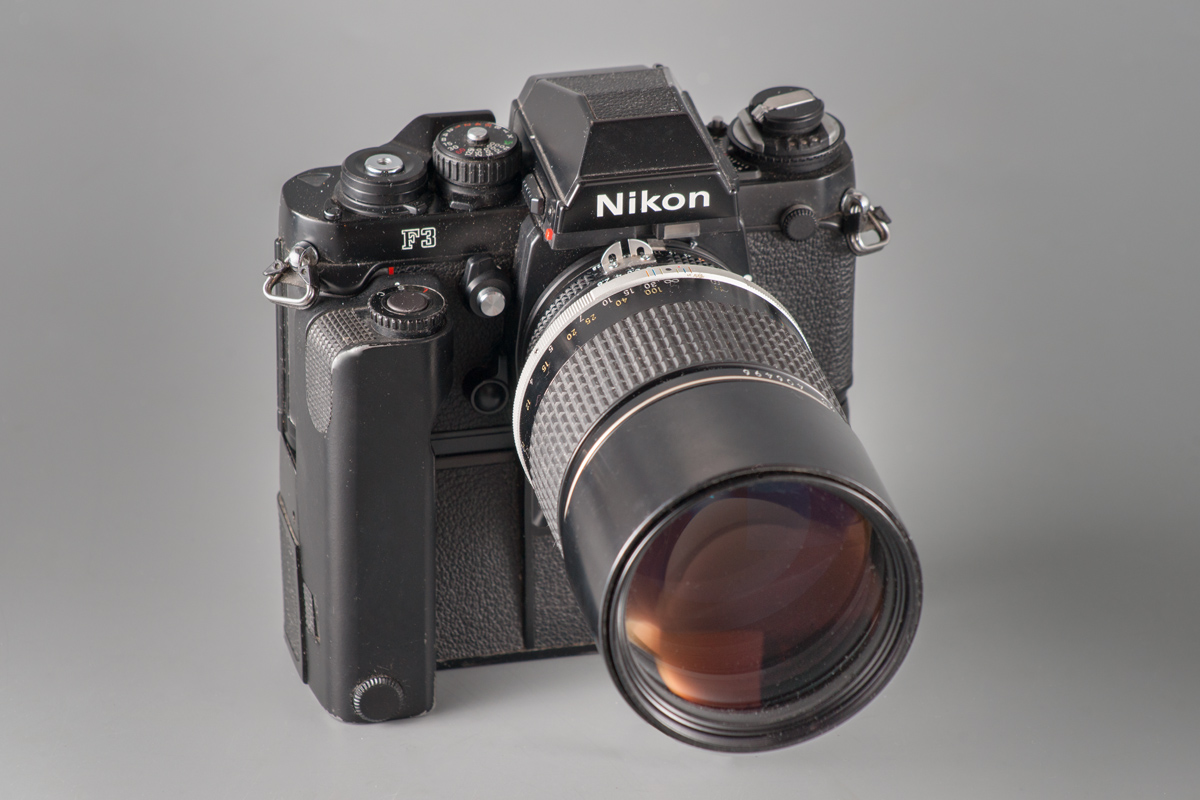
_________________
www.artaphot.ch |
|
| Back to top |
|
 |
kansalliskala


Joined: 19 Jul 2007
Posts: 5046
Location: Southern Finland countryside
Expire: 2016-12-30
|
 Posted: Wed Feb 22, 2023 6:22 am Post subject: Re: Nikon F3 with different lenses Posted: Wed Feb 22, 2023 6:22 am Post subject: Re: Nikon F3 with different lenses |
 |
|
kansalliskala wrote:
| stevemark wrote: |
And finally with a nice looking Nikkor AiS 2.8/180mm ED:
 |

is it glued on the table?
_________________
MF: Kodak DCS SLR/c; Samsung NX10; OM-10; Canon T50
Zuiko 28/3.5, Distagon 35/2.8; Yashica ML 50/2;
Zuiko 50/1.4; S-M-C 120/2.8; Zuiko 135/3.5; 200/5;
Tamron AD1 135/2.8, Soligor 180/3.5; Tamron AD1 300/5.6
Tamron zooms: 01A, Z-210
Yashicaflex C; Київ 4 + Юпитер 8, 11; Polaroid 100; Olympus XA; Yashica T3
Museum stuff: Certo-Phot; Tele-Edixon 135; Polaris 90-190; Asahi Bellows; Ixus IIs
Projects: Agfa Isolette III (no shutter), Canon AE-1D (no sensor),
Nikon D80 (dead), The "Peace Camera"
AF: Canon, Tokina, Sigma Video: JVC GZ-MG275E |
|
| Back to top |
|
 |
Doc Sharptail


Joined: 23 Nov 2020
Posts: 1216
Location: Winnipeg Canada
|
 Posted: Wed Feb 22, 2023 6:38 pm Post subject: Re: Nikon F3 with different lenses Posted: Wed Feb 22, 2023 6:38 pm Post subject: Re: Nikon F3 with different lenses |
 |
|
Doc Sharptail wrote:
| kansalliskala wrote: |

is it glued on the table? |
No- the F-3 was literally a heavy-weight with the MD-4 and it's 8 ( ! ) A/A batteries.
IIRC, it took the old vivitar series 1 70-210 f3.5 to tilt it with a full battery pack.
It stayed level with everything else.
While not a personal favorite, the system despite a few design flaws was a good one, and a bit of a prestige symbol as well.

This is more my speed here. YMMV! 
Driveless chrome F2 with Soligor 135mm aboard.
Note lens cap support below the lens.
-D.S.
_________________
D-810, F2, FTN.
35mm f2 O.C. nikkor
50 f2 H nikkor, 50 f 1.4 AI-s, 135 f3.5 Q,
50 f2 K nikkor 2x, 28-85mm f3.5-4.5 A/I-s, 35-105 3.5-4.5 A/I-s, 200mm f4 Micro A/I, partial list.
"Ain't no half-way" -S.R.V.
"Oh Yeah... Alright" -Paul Simon
Last edited by Doc Sharptail on Fri Feb 24, 2023 8:13 am; edited 1 time in total |
|
| Back to top |
|
 |
stevemark

Joined: 29 Apr 2011
Posts: 4088
Location: Switzerland
|
 Posted: Thu Feb 23, 2023 12:09 am Post subject: Re: Nikon F3 with different lenses Posted: Thu Feb 23, 2023 12:09 am Post subject: Re: Nikon F3 with different lenses |
 |
|
stevemark wrote:
| kansalliskala wrote: |

is it glued on the table? |
 ... No. Just an (invisible) match supporting the lens. ... No. Just an (invisible) match supporting the lens.
The F3 motor drive - as Doc has mentioned - has a flat bottom. This, combined with the grip's bottom (which also is flat), results in the "F3 & motor" standing really stable.
| Doc Sharptail wrote: |
While not a personal favorite, the system despite a few design flaws was a good one, and a bit of a prestige symbol as well.
This is more my speed here. YMMV! 
Driveless chrome F2 with Soligor 135mm aboard.
Note lens cap support below the lens.
-D.S. |
The F3 is a really nice camera. Without motor drive it is pretty small. Also the FE2 is fantastic. It has just all what you really need in an MF SLR, but nothing more. "F2 & lens" images will follow later on, but for time being here my Canon EOS 1D MkII with the 17mm shift lens attached 

S
_________________
www.artaphot.ch |
|
| Back to top |
|
 |
ZuikosHexanonsandVivitars


Joined: 03 Nov 2021
Posts: 254
Location: Austria
|
 Posted: Thu Feb 23, 2023 11:06 pm Post subject: Posted: Thu Feb 23, 2023 11:06 pm Post subject: |
 |
|
ZuikosHexanonsandVivitars wrote:
| stevemark wrote: |
Did you know there was a very sophisticated Olympus Zuiko 1.4/85mm, too? Prototype only, though ...  |
Yes, I knew!  Since I regularly visit this website here, I happened to come across the article of the 1.4/85 prototype. Lots of other interesting stuff in there, i.e. the patent no. I mentioned in my previous post I found there. Since I regularly visit this website here, I happened to come across the article of the 1.4/85 prototype. Lots of other interesting stuff in there, i.e. the patent no. I mentioned in my previous post I found there.
https://olypedia.de/index.php?title=OM-System
| stevemark wrote: |
I only know the 2.8/135mm which I got a year ago for about CHF 40.-- from a photo dealer in Zurich. To be honest - I haven't really been using it, just a few test shots. Maybe I should try it again. Both the 2.8/100mm (which occasionally appears here in Switzerland) and the 2.8/180 look pretty interesting to me, but since they usually are pretty expensive I didn't buy them. And collecting the more interesting f2 Oly lenses immediately gets even more expensive. occasionally they appear here, too, but the sellers often want >1000.-- for these lenses (2/21, 2/24, 2/50 Macro, 2/90 Macro, 2/100). |
http://forum.mflenses.com/olympus-zuiko-135mm-f2-8-sunrise-t84067.html
Not very helpful if one wants to judge the capability of a lens, but beautiful nevertheless. I should use it more often, too. Congratulations on the price of yours... 
I didn´t forget about the 180mm test images I mentioned in my previous post. I´ll be in the mountains next week and will take it with me, hoping for the muse to kiss me. I took a few images with it so far, but nothing good enough for a new topic in the galleries.
| stevemark wrote: |
| My Olympus Zuiko 4.5/300 fringes quite a bit too, but that's more a problem of the focal length than of coating. Most vintage 300mm do this, apart from the "APO" / ULD / ED / AD glass. Even the Nikkor AiS IF-ED 4.5/300mm has quite a lot of fringing! |
Thanks for mentioning that. I had the slight hope to run across an MC version sooner or later and grab it. I might reconsider 
_________________
Cheers, Gerhard |
|
| Back to top |
|
 |
stevemark

Joined: 29 Apr 2011
Posts: 4088
Location: Switzerland
|
 Posted: Fri Feb 24, 2023 2:20 am Post subject: Posted: Fri Feb 24, 2023 2:20 am Post subject: |
 |
|
stevemark wrote:
| ZuikosHexanonsandVivitars wrote: |
| stevemark wrote: |
| My Olympus Zuiko 4.5/300 fringes quite a bit too, but that's more a problem of the focal length than of coating. Most vintage 300mm do this, apart from the "APO" / ULD / ED / AD glass. Even the Nikkor AiS IF-ED 4.5/300mm has quite a lot of fringing! |
Thanks for mentioning that. I had the slight hope to run across an MC version sooner or later and grab it. I might reconsider  |
If you want a "cheap" FF lens in the 300mm range which is APO, get the Mamiya Sekor C 5.6/300mm. No need to get the later Mamiya Sekor C 5.6/300mm ULD (I have both, and they are absolutely identical). Both Mamiya Sekor C 5.6/300mm lenses mentioned are (in the visible) as good as the legendary Nikkor Ai 4.5/300mm ED "non-IF" which is corrected from 400nm to 1000nm. I can't check its IR performance though ...
_________________
www.artaphot.ch |
|
| Back to top |
|
 |
|
|
